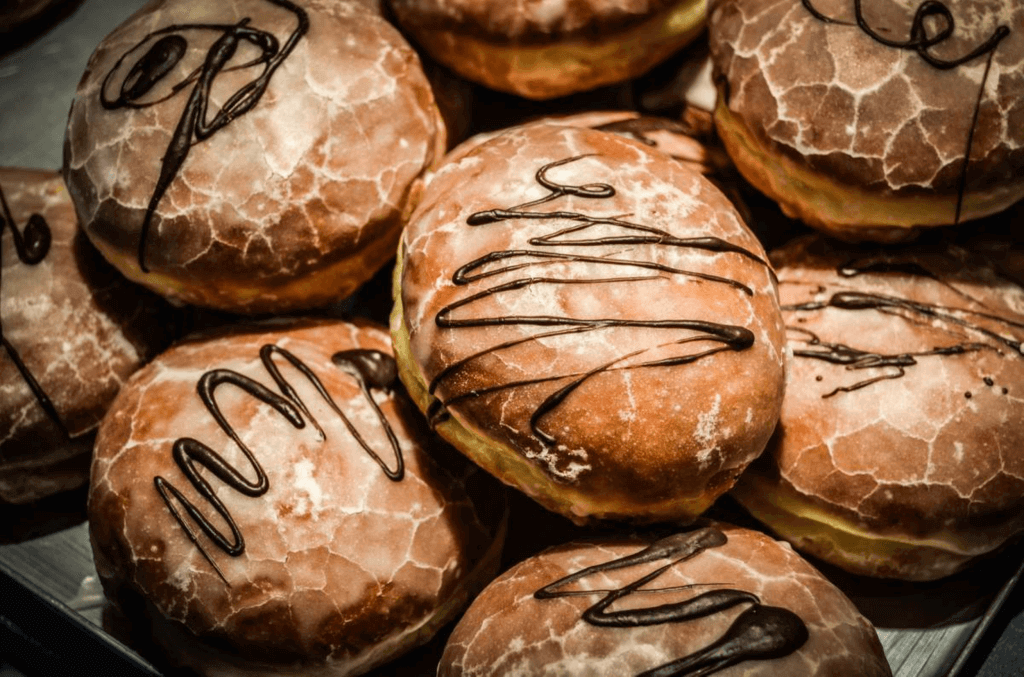Pączki Day
Pączki Day is observed next on Tuesday, February 17th, 2026 (64 days from today).

In Polish, Pączki is the name of a traditional donut that is very popular here. Similar to American donuts, the main ingredients to make this special cake include: flour, eggs, milk and are evenly cooked by deep frying in oil. To show the love for Pączki cakes, Pączki Day is celebrated every year the day before Ash Wednesday. This is also a Polish tradition.
The reason handed down to clearly explain the birth of this cake is that people in Poland want to take advantage of all the flour, eggs, milk, tallow and cream as well as fruit jams in their families before they all enter the Catholic month of fasting. That is probably the biggest reason why the last Thursday before the month of fasting is always synonymous with Pączki Day in Poland. When walking around the streets these days, you won't be able to resist the aroma of the wonderful traditional donuts that are constantly being baked from shops, bakeries and households.
History of Pączki Day
Pączki Day is said to have originated in the Middle Ages. And to this day, Pączki Day is still loved and popular, especially in the Catholic community.
Observing Pączki Day
To celebrate Pączki Day, you can go to the store and buy yourself Pączki cakes to enjoy them. Plus you can also make your own Pączki according to the recipe below:
A traditional Pączki is usually topped with powdered sugar and is filled with stewed plum jam with wild rose petal jam inside. However, in today's variation recipes, people have also replaced different fillings with popular and personal jams such as strawberry jam, apple jam, raspberry jam, blueberry jam and even filling custard cream.
Resources:
- About 450g all-purpose flour
- About 250ml of fresh milk without sugar
- 2 egg yolks
- About 60g of unsalted butter, melted and cooled
- About 50g of white granulated sugar
- About 7g dry yeast, 2g salt
- About 2ml vanilla essence
- Powdered sugar
- Fruit jam or custard cream (for filling)
Making:
Step 1: Heat 1/2 of the fresh milk, so that the milk is at an average temperature of about 35-40 degrees Celsius (not hotter, it will kill the yeast or weaken its activity). Put 5 grams of sugar and all this yeast into the milk, stir with wooden chopsticks. After about 5-10 minutes, you will see the glaze forming a patch, a bit like crab bricks. If the yeast does not bloom, there are about two possibilities, either the yeast has a problem, or the milk is too hot to kill the yeast, so throw it away and prepare to start over.
Step2: Sift flour, sugar, salt & milk powder (if available) into a bowl. Mix. Put the remaining ingredients including yeasted milk butter, eggs, and 1/2 of the remaining milk in a bowl. Mix until the mixture comes together with a wooden spoon. Cover the bowl with a damp towel and let the dough rest for 8-10 minutes. Letting the dough rest will make the dough less sticky and easier to knead in the case of hand kneading. If kneading the dough by machine, this step may not be necessary.
Step 3: Pour the dough on a table covered with a thin layer of flour, if the dough is too wet and sticky (maybe because the flour is poorly absorbent), you can use a little more flour during the kneading process (dry flour) to spread evenly over the tabletop and rub hands, to make kneading easier However, try to use as little powder as possible. If kneading by hand, it will usually take about 15-20 minutes. After the dough is kneaded, it will be flexible and elastic. If you press your finger on the surface of the dough, it will swell again.
Step 4: Put the dough into a bowl that has been coated with a very thin layer of cooking oil. Turn the dough over so that the cooking oil is evenly coated on the outside of the dough (to prevent the dough from drying out quickly during the incubation process. Cover the bowl with plastic wrap (or cover the bowl with a damp cloth), incubate the dough until the dough has doubled in size at a temperature of 30-38 degrees C. To check if the dough has risen, press lightly with one or two fingers into the dough, about 1-2cm deep. After withdrawing your hand, if the indentation remains, it means the dough has been annealed.
Step 5: After the dough has risen enough, use the back of your hand to press or lightly punch to deflate the air bubbles in the dough. Remove the dough from the bowl, knead again briefly for about 1-2 minutes. Coat a little dry flour on the tabletop and rolling pin, roll the dough into a piece about 0.7 - 1 cm thick. Cover the dough with plastic or a damp cloth, let the dough rest for about 5-7 minutes (to prevent the cake from shrinking after cutting). Cut the dough into a round doughnut shape.
Step 6: Second incubation: Wrap the whole dough tray and incubate at room temperature, if it is hot. Or turn on the oven about 50 degrees Celsius for 5 minutes and then turn off the oven, put the dough tray in the oven, add a cup of boiling water (to keep it moist), incubate the cake at a temperature of 35-40 degrees Celsius until the cake expands about 80 %.
Step 7: Fry the cake: Prepare a small pot, pour a lot of oil. Heat the oil to about 150 - 170 degrees Celsius, then drop the cakes in and fry until golden on one side, flip and fry the other side until golden. Remove the cake to a plate lined with absorbent paper to absorb excess grease.
Although it seems difficult to do, it will be interesting, meaning you can make it yourself and your close friends. Share your Pączki on social media with the hashtag #PaczkiDay
Observed
Pączki Day has been observed 47 days before Easter.Dates
Tuesday, February 13th, 2024
Tuesday, March 4th, 2025
Tuesday, February 17th, 2026
Tuesday, February 9th, 2027
Tuesday, February 29th, 2028


